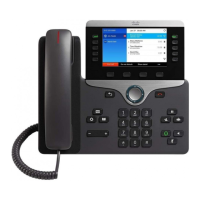802.11r / Fast Transition (FT) is the recommended deployment model for all environment types where frequent roaming occurs.
802.1x authentication is required in order to utilize CCKM.
802.1x without 802.11r (FT) or CCKM can introduce delay during roaming due to its requirement for full re-authentication.
WPA and WPA2 introduce additional transient keys and can lengthen roaming time.
When 802.11r (FT) or CCKM is utilized, roaming times can be reduced from 400-500 ms to less than 100 ms, where that
transition time from one access point to another will not be audible to the user.
The Cisco IP Phone 8800 Series supports 802.11r (FT) with WPA2 (AES or TKIP) or WPA2-PSK (AES or TKIP) and CCKM
with WPA2 (AES or TKIP) and WPA (TKIP or AES).
The Cisco IP Phone 8800 Series manages the scanning and roaming events.
The roaming trigger for the majority of roams should be due to meeting the required RSSI differential based on the current
RSSI, which results in seamless roaming (no voice interruptions).
For seamless roaming to occur, the Cisco IP Phone 8800 Series must be associated to an access point for at least 3 seconds,
otherwise roams can occur based on packet loss (max tx retransmissions or missed beacons).
Roaming based on RSSI may not occur if the current signal has met the strong RSSI threshold.
Note: The Cisco IP Phone 8800 Series does not utilize the RF parameters in the Client Roaming section of the Cisco Unified
Wireless LAN Controller as scanning and roaming is managed independently by the phone itself.
Interband Roaming
The Cisco IP Phone 8861 defaults to Auto for the frequency band mode, which enables interband roaming and currently gives
preference to the strongest signal. Typically this will give preference to 2.4 GHz over 5 GHz due to 2.4 GHz having a stronger
signal in general assuming the power levels are the same.
At power on, the Cisco IP Phone 8861 will scan all 2.4 and 5 GHz channels when in Auto mode, then attempt to associate to an
access point for the configured network if available.
If configured for 5 GHz only or 2.4 GHz only mode, then just those channels are scanned.
It is recommended to perform a spectrum analysis to ensure that the desired bands can be enabled in order to perform interband
roaming.
Multicast
When enabling multicast in the wireless LAN, performance and capacity must be considered.
If there is an associated client that is in power save mode, then all multicast packets will be queued until the DTIM period.

